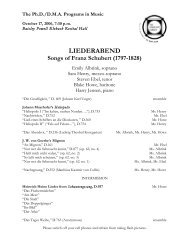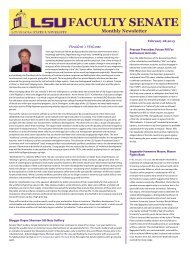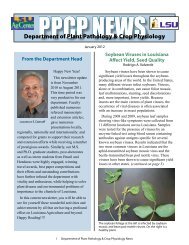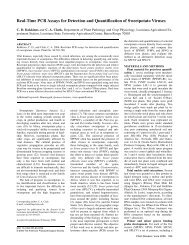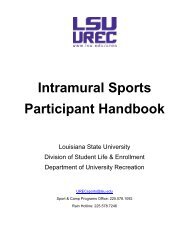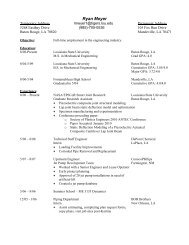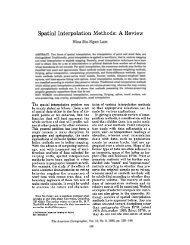FACULTY SENATE - Louisiana State University
FACULTY SENATE - Louisiana State University
FACULTY SENATE - Louisiana State University
You also want an ePaper? Increase the reach of your titles
YUMPU automatically turns print PDFs into web optimized ePapers that Google loves.
Regents Demystify Common Come<br />
Every day, <strong>Louisiana</strong>’s newspapers—and the folks who write editorials and editorial letters—churn up new causes for<br />
concern about the new common core standards for the public schools that supply the plurality of students in <strong>Louisiana</strong><br />
higher education institutions. In response, that Casanova-level lover of data and debunker-in-chief, Commissioner Jim<br />
Purcell, has issued a thoughtful and carefully crafted information sheet concerning the myths that have arisen around<br />
these new requirements. Inquirers who would like to learn more about the common core standards (or who would like<br />
to uncover the reality behind the controversy concerning same) may visit a dedicated web page”Myths and Facts about<br />
the Common Core Standards.” Deep within the common core controversy abides the work of another organization,<br />
PARCC (Partnership for Assessment of Readiness for college and Career) that coordinates the work of nineteen states as<br />
they attempt to create reasonable modern standards for proficiency in English and Mathematics. Commissioner Purcell<br />
has provided a portal to PARCC as well as an array of PARCC-related information at a second dedicated web page .<br />
Only one minor suggestion for the understated but heavily qualified Commissioner: Please, no more artfully posed but<br />
unfortunately obviously canned file photos of groups of ethnically diverse, relentlessly smiling students in the mastheads<br />
of web pages!<br />
Middle Management Midsummer Bonanza at UNO<br />
Summer brought an early harvest of lucrative middle-management sinecures at the <strong>University</strong> of New Orleans. Elevations<br />
to the management caste included the appointment of Kevin Graves as Interim Dean of Liberal Arts at an annual salary<br />
of $140K; the lifting of Darrell Kruger to the position of Dean of Education and Human Development at a per annum rate<br />
of $155K (it being a remarkable feature of our time that those specializing in development earn more than those in the<br />
liberal arts, which have already developed—but, then again, young wine sometimes commands higher prices than old<br />
vinegar); the situating of John A. Williams in the post of Dean of Business Administration for $200K; the designation of<br />
Kenneth Sewell as the Vice-Presidency of Research and Economic Development with a salary of $185K; and the anointing<br />
of Gregg Lassen as VP for Business Affairs, with Lassen crashing the two-hundred level at $215K. Total salary awarded<br />
approached $900K, which, with fringe, rounds out to something closer to $1.2M. In other <strong>University</strong> of <strong>Louisiana</strong> System<br />
salary action, Southeastern favored a new interim Athletic Director with a dollop of $135K while also contracting the<br />
new interim Dean of Education to an emolument of $120K. Amusingly, in his CV, the new Athletic Director cites, in<br />
the subjunctive voice, a personal objective of attaining of a position where “prior experience, personal ability, and a<br />
commitment to professionalism would be of value”—but that “would” somehow slipped into the bigtime indicative. Up<br />
at LaTech, Dan Reneau awarded Stan Napper an appointment as VP for Research and Development at $180K per year.<br />
Regents Update, Beautify Website<br />
Until recently, “up-to-date” at the Board of Regents web site tended to mean something like “up to a certain date,<br />
perhaps around 1997.” Now, thanks to the leadership of the genial Jim Purcell, the Regents office has made some big if<br />
initial steps toward the energizing of its Internet presence . The upgrade is most evident on the Regents’ main, “home”<br />
page, where an attractive new color scheme<br />
visually cues visitors to the location of important<br />
links and buttons such as those pertaining to the<br />
LAGRAD Act or to the state master plan. Some<br />
work remains to be done. As the user moves<br />
deeper into the menus, some of the old bland<br />
lists of inadequately denominated or<br />
insufficiently distinguished documents drift<br />
back into view. More than a few file photos<br />
give the site an occasional ready-made look.<br />
Overall, however, the new site communicates<br />
a sense of vigor and enthusiasm that the<br />
Claiborne Building has not transmitted<br />
New Regents Website<br />
in a good many years.<br />
College of Engineering Engages LSU and BRCC Faculty for Active Teaching Strategies<br />
By Elise Bernard<br />
Often college professors struggle for professional opportunities to engage in effective instructional techniques to<br />
help retain students in science, technology, engineering and math fields to graduation. In an effort to combat dropout<br />
rates among STEM students, LSU College of Engineering’s Science, Technology, Engineering and Mathematics Talent<br />
Expansion Program (STEP) hosts an annual Faculty Development Workshop to facilitate active learning strategies as part<br />
of the “Bears to Tigers” partnership between Baton Rouge Community College and LSU.<br />
Twenty seven faculty members from LSU and BRCC gathered May 20-22 for a three-day workshop on the LSU campus<br />
to enhance professional and instructional skills and motivate faculty with innovative teaching tools. The program allows<br />
BRCC and LSU faculty to meet and coordinate courses for the “Bears to Tigers” partnership that supports students who<br />
have completed the Associate of Science in Engineering degree at BRCC and will transfer into a Bachelor of Science<br />
degree program at LSU in a College of Engineering discipline.<br />
Facilities Utilization: Biggest is not<br />
Needliest<br />
One of the unchallenged assumptions among highereducation<br />
spectators is the conjecture that the<br />
biggest institutions ought to do the most building.<br />
The greatest number of students (or at least student<br />
credit hours) ought to justify the greatest amount of<br />
space. Unfortunately for devotees of that superstition,<br />
universities grow or shrink at irregular rates, with<br />
building construction or demolition lagging behind<br />
the population curve. The latest space “utilization”<br />
[sic—try “use”] report, based on 2012 data, reveals<br />
that <strong>Louisiana</strong>’s behemoth universities are not the<br />
most needy when it comes to additional square<br />
footage. Based on the “space factor” measure, the ratio<br />
of aggregate square footage to student clock hours,<br />
several LCTCS schools—Sabine Valley, Shreveport-<br />
Bossier, River Parishes, and Northeast—top the list of<br />
those squeezed for floor space. At the other end of<br />
the Spectrum, Lafourche Technical College bagged<br />
a massive 12.86 on a space factor spectrum in which<br />
a low number such as Sabine’s 0.40 indicates either<br />
desperation for space or efficiency or both.<br />
OGB Lowers Fees but Spikes LSU First<br />
Dr. Samuel Johnson, the eighteenth-century British wit,<br />
observed that the bad thing about wages is that they<br />
are always increased but never lowered. Apparently<br />
“the great Cham” never worked in a <strong>Louisiana</strong> university,<br />
but the point that prices not only for labor but<br />
indeed for everything tend to go up is supported by<br />
a preponderance of the evidence. It therefore came<br />
as a huge surprise to most consumers of <strong>Louisiana</strong>affiliated<br />
health insurance that the Office of Group<br />
Benefits lowered rates for most health coverage by<br />
one and three-quarters percent. How could that be?<br />
Well, the folks on the “fourth floor” have tried for a long<br />
time to redirect the half-billion dollar reserve that OGB<br />
had accumulated so as to make privatization easier<br />
(by lowering the price of acquiring <strong>Louisiana</strong> health<br />
plans) and so as to push participants’ dollars back into<br />
the state general fund. And then there is LSU’s “LSU<br />
First” policy, which is in every way better than any state<br />
offering and that operates outside the control of the<br />
aforementioned “fourth floor.” Driving down OGB rates<br />
drives down premiums on LSU First, thus diminishing<br />
its ability to provide benefits to the faculty who have<br />
always applauded this insurance offering. In a final<br />
strange twist to this story, legislators, who occasionally<br />
show some independence from the governor, not only<br />
continue to enjoy the special privilege of access to LSU<br />
First but have also convinced the LSU System to open<br />
up that policy to members of their staffs.<br />
Campus Federal Launches A2A and P2P<br />
Transfer Options<br />
<strong>State</strong>wide academic banker Campus Federal Credit<br />
Union has again leapt into the lead among specialty<br />
financial institutions with the release of its person-toperson<br />
and account-to-account online transfer utility<br />
that bodes fair to replace the old-fashioned checkbook<br />
with a faster, more secure electronic transfer option.<br />
At press time, CFCU had posted an instructional video<br />
concerning this new utility on its main web page.<br />
Congratulations to John Milazzo and his team for<br />
another laudable innovation.<br />
(continued on page 7)




